2 The Evolution Of Chinese Characters, Calligraphy Writing Tools, And Writing Techniques
Part I. Culture
1 Evolution of Chinese Characters: Oracle Bones (甲骨文)
甲骨文/jiǎ gŭ wén, or oracle bones, represent the earliest forms of Chinese writing (the middle to late Shang Dynasty 商/shāng, 1,500-1,000 BC). Etched on turtle shells and animal bones (see Figure 1), this crudely written script was thought to have divine implications by Shang rulers. Ever since, they have provided clues into the life and times of an era long considered mythological rather than historical. Their rudimentary characters resemble objects they represent. Thus, they are considered pictographs (象形字/xiàng xíng zì).
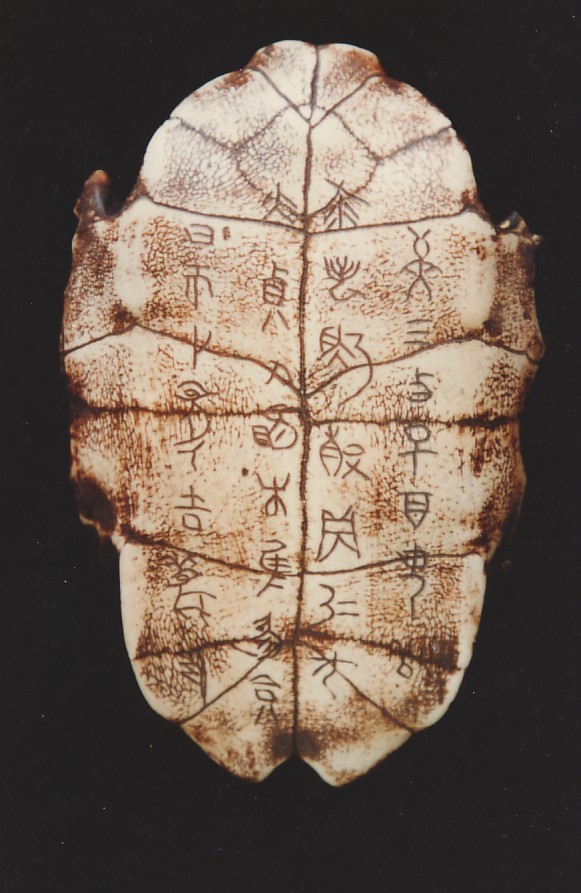 |
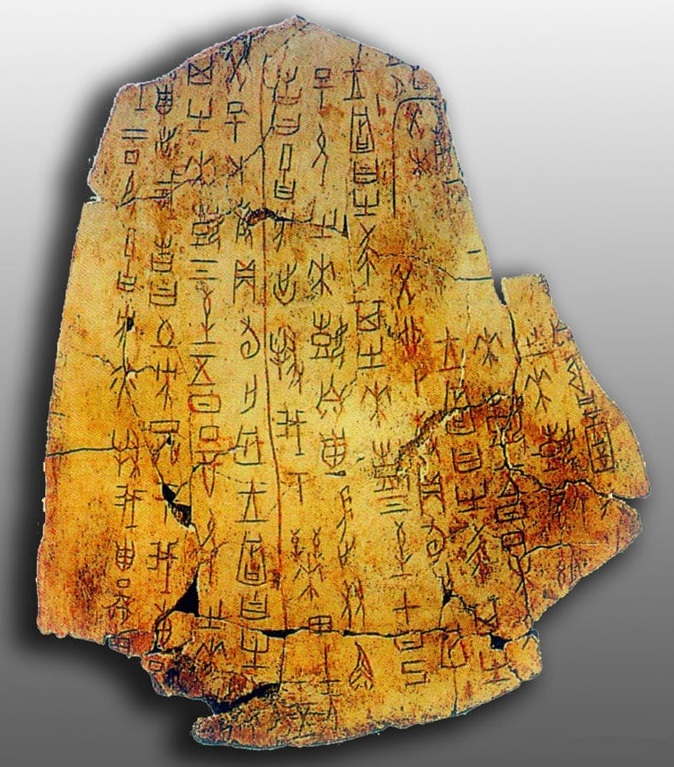 |
Figure 1: Script on turtle shell and ox bone
Examples – Oracle Bone Script
| Pinyin | mǎ | hǔ | shĭ | quǎn | shǔ | xiàng |
| Modern Form | 马/馬 | 虎 | 豕 | 犬 | 鼠 | 象 |
| Meaning | horse | tiger | swine | dog | rat | elephant |
2 Writing Tools and Materials: 文房四宝/文房四寳/wén fáng sì băo (The Four Treasures of Study)
- Brush (笔/筆)
Calligraphers as well as artists use ink brushes known as 笔/筆/bĭ or 毛笔/毛筆/máo bĭ, a tool the Chinese invented around 300 BC. Along with an ink stone, 砚/硯/yàn, an ink stick, 墨/mò, and a certain type of rice paper, 纸/紙/zhĭ, known as 宣纸/宣紙/xuān zhĭ, they form the essential building blocks of calligraphy.
Primitive brushes featured bamboo that enabled hair to be bound to a wooden stalk. Since then brushes have had multiple, versatile uses, with stalks composed of jade, gold, and silver.
Common or normal brushes are made of three types of hair. The first type is the hair of a goat, called 羊毫/yáng háo, soft and better suiting for running-script writing; the second is of a weasel, 狼毫/láng háo, resilient and better for writing of regular and cursive styles; and the third type is of mixture of both hair types, 兼毫/jiān háo. Hair from a pig, a mouse, and a rabbit is also used. Regardless of style, they can be soft, mixed or hard, in big, medium or short sizes, depending on application.
P.E.R.R. Criteria for recognizing and maintaining a brush-tuft: 尖齐圆健/尖齊圓健/jiān qí yuán jiàn, P(ointy), E(ven), R(ound), & R(esilient)
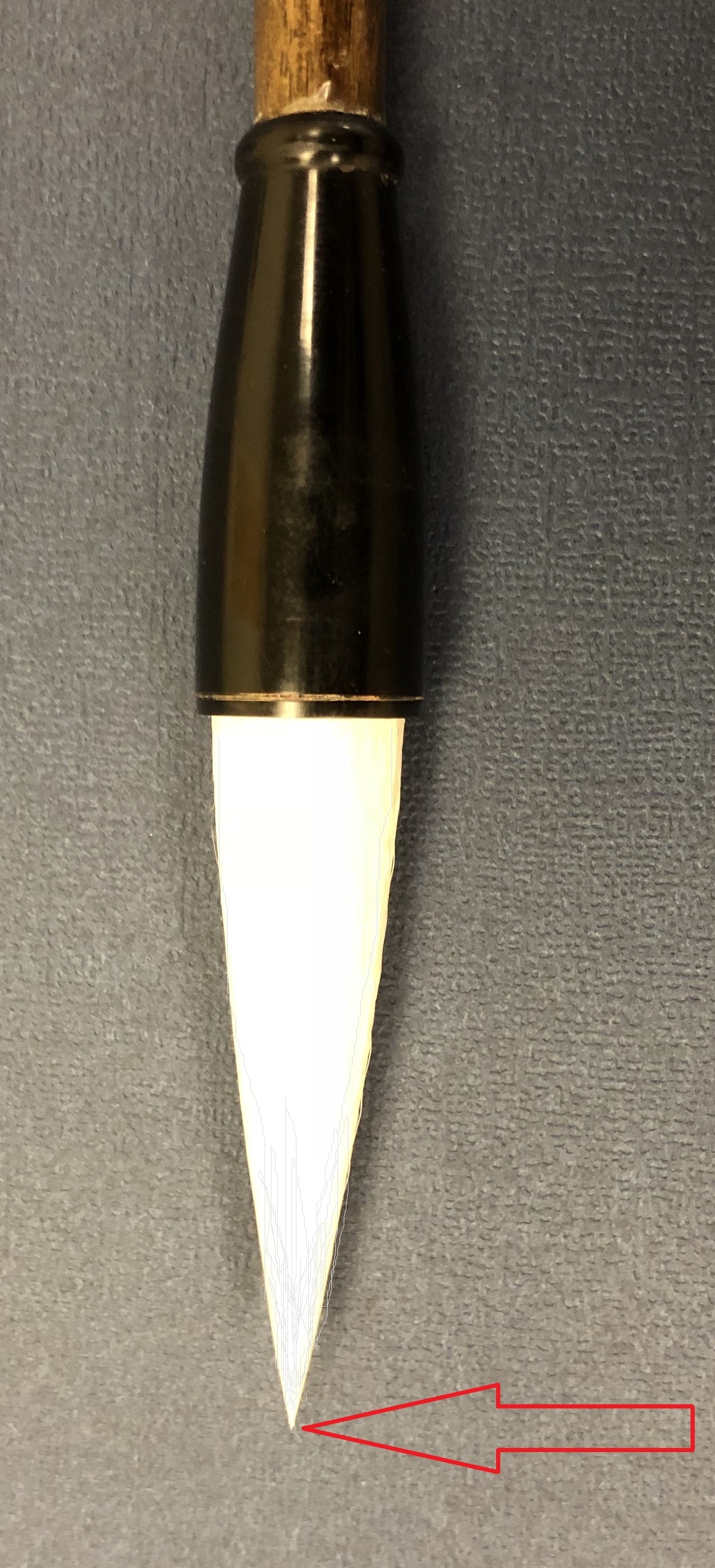 |
 |
 |
 |
Figure 2: P.E.R.R. Criteria for a good brush
- Ink Stick (墨)
Although meaning ink, 墨/mò traditionally refers to ink sticks. Ink sticks are typically made of soot and glue. When the stick is ground against a stone ink appears, 砚/硯/yàn (see ink stone below). Once water is added, one can begin applying ink to brush. Serious calligraphers and painters prefer high-quality ink stones as they think the stone itself has a great deal to do with the quality and texture of the ink that is ground upon it. Four types of most treasured ink stones include Duan Yan (端砚/端硯), She Yan (畲砚/畲硯), Taohe Yan (洮河砚/洮河硯), and Chengni Yan (澄泥砚/澄泥硯).
- Paper (纸/紙)
Rice paper, 宣纸/宣紙/xuān zhĭ, is made of blue sandalwood bark and rice straw. It is known for its fine, soft texture – features favored by calligraphers and painters. 宣 in the name 宣纸/宣紙 refers to 宣州 (a city in Anhui Province) which is famous for rice-paper manufacturing. Compared with regular paper, rice paper is more absorbent and resistant to wrinkles.
- Ink Stone (砚/硯)
砚/硯 refers to a mortar of stone that calligraphers and painters have used for centuries to grind and hold ink. In addition to stone, ink stones are also manufactured from clay, bronze, iron, and porcelain. Having evolved from a device that individuals used to create dyes, the ink stone probably dates to the 3rd Century BC.
- Seal (印)
Known as 印/yìn or 印章/yìn zhāng, a seal is a general name for printing stamps which are used in lieu of, or together with, signatures in personal documents, office paperwork, artwork, or any item requiring the indication of authorship or ownership. Chinese seals are typically made of stone (for common users), jade (for emperors and high-ranking officials in the past), or other materials. Seals are used with red ink or cinnabar paste. One fascinating aspect of a seal is that each is unique and often reflects the owner’s personality. One can see a seal’s distinctive red ink on traditional paintings throughout China and elsewhere in Asia.
In addition to these Four Treasures, a calligrapher should have other tools. These include, but are not limited to, a desk pad (毛毡/máo zhān), a paperweight (镇纸/鎭紙/zhèn zhĭ), a brush hanger (笔挂/筆掛/bĭ guà), and a seal ink-pad (印泥/yìn ní).
*
Part II. Calligraphy Writing
1 Writing Techniques: 起笔/起筆 and 收笔/收筆 Techniques
起笔/起筆/qĭ bĭ refers to the method of starting a stroke, while 收笔/收筆/shōu bĭ is the way to end a stroke. Beginning a stroke in calligraphy differs from regular writing. For example, the beginning of regular vertical, horizontal, and left falling strokes requires a backward start and then a change in expected direction. Likewise, the end of a series of strokes such as the vertical, horizontal, and even the left and right falling strokes sometimes requires a backward finish after the brush reaches the stroke end. This is also true in clerical script writing, where almost all strokes need a directionally opposite beginning or end to make the strokes look alike 蚕头燕尾/蠶頭燕尾/cán tóu yàn wĕi (see Chapter 5 for more details).
2 Strokes That Compose Characters
2.1 Left Falling (撇)
The left falling stroke (撇/piě) always starts at the top right and angles to bottom left as the brush leaves the paper. See the directional arrows in the outlined long and short left-falling strokes.
 |
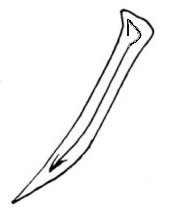 |
 |
 |
Figure 3: Long and short left-falling strokes and writing directions
*
2.2 Right Falling (捺)
The right falling diagonal stroke (捺/nà) always starts at the top left and angles to bottom right as the brush leaves the paper. See the directional arrows in the outlined diagonal and flat strokes.
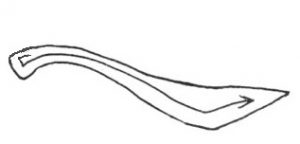 |
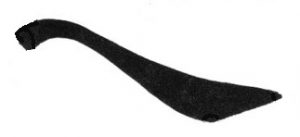 |
Figure 4: Diagonal right-falling strokes and flat right-falling strokes
3 Composing Characters
3.1 Stroke Order
Arch Chinese lists 12 rules of Chinese character writing order. Below are Rules 4 -6:
- Rule 4: Cutting strokes last (e.g., 干 and牛)
- Rule 5: Diagonals right-to-left before diagonals left-to-right (e.g., 人, 天, and 木)
- Rule 6: Center verticals before outside “wings” (e.g., 木 and 小)
For details, visit the Arch Chinese website. Yellowbrigde Online Dictionary can also provide additional information. Please note that the actual stoke order in calligraphy is sometimes different from that in regular writing. These rules only guide a practitioner. We cannot count on rules to dictate the exact stroke order for all specific characters. When in doubt, refer to dictionaries.
3.2 Characters
人/rén/human being; person, 牛/niú/cow; ox, 走/zŏu/to walk; to leave, 木/mù/wood; tree
3.3 Writing Samples
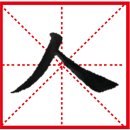 |
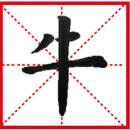 |
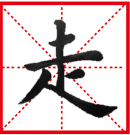 |
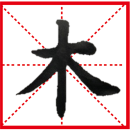 |
3.4 Writing by Following Rules
- Prepare the tools and materials.
- Start to write under instruction.
- Be aware of rules for posture and stroke order.
*
4 Homework
Write 井/jĭng/well, 本/bĕn /fundamental; measure word for books, 天/tiān/sky; day, and 仁/rén/benevolent; benevolence.
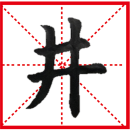 |
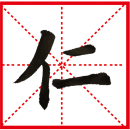 |
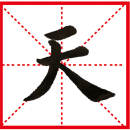 |
 |
Part III. Additional Resources
- Additional readings: http://www.chinaonlinemuseum.com/
- The story of a Chinese character: 木 https://www.youtube.com/watch?v=kUZMQBNhSTo
- The story of a Chinese character: 天https://www.youtube.com/watch?v=z2Q6VMJ1I2E
- The story of a Chinese character: 人https://www.youtube.com/watch?v=zdIj9N2313w

